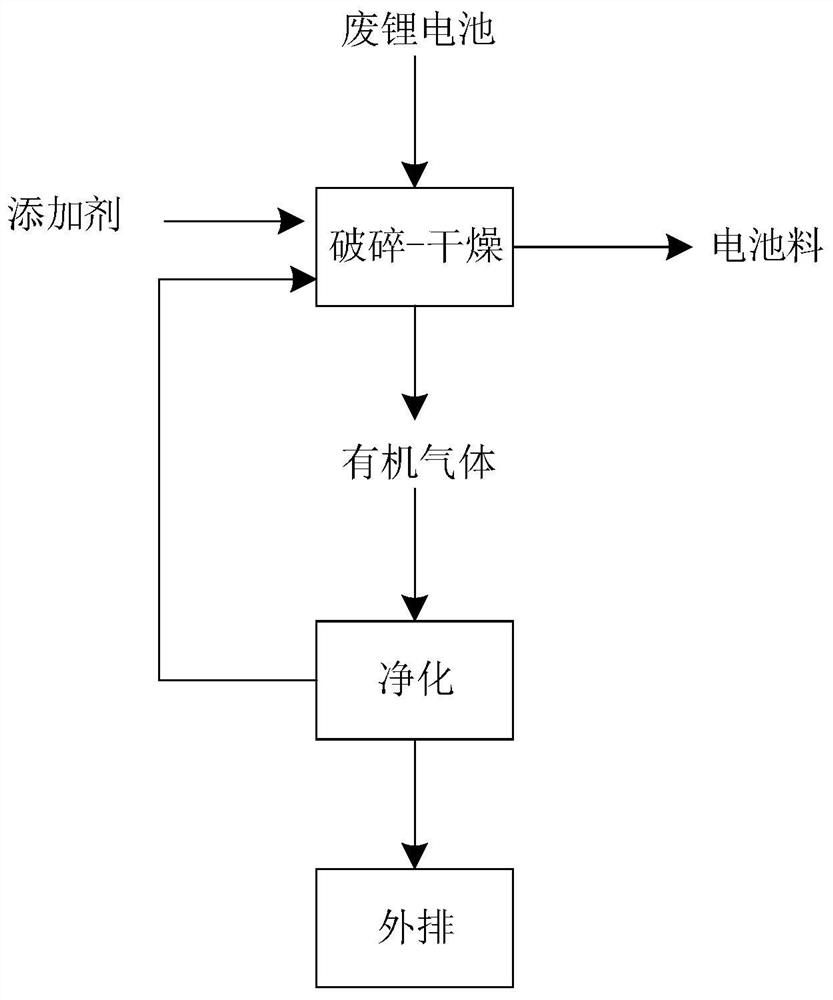Harmless treatment method for waste lithium battery electrolyte
A treatment method and electrolyte technology, applied in the field of environmental protection, can solve problems such as inability to effectively treat electrolyte
- Summary
- Abstract
- Description
- Claims
- Application Information
AI Technical Summary
Problems solved by technology
Method used
Image
Examples
Embodiment 1
[0048] This embodiment provides a harmless treatment method for waste lithium battery electrolyte, and the treatment method includes the following methods:
[0049] (1) Carry out crushing treatment and drying treatment to the waste lithium battery after discharge successively, obtain the battery material and organic gas that remove electrolyte; The time interval of the drying treatment is 20s, and the end point of the crushing treatment is to make the material with a particle size<50mm account for 90wt% of the total material; during the drying treatment, the removal rate of the electrolyte is 90%; the temperature of the drying treatment is 150°C, the treatment time is 30s, and the drying treatment method is hot air drying;
[0050] (2) After the organic gas is dedusted, the temperature is raised to 150° C., and part of it is reused in the drying treatment described in step (1), and the remaining gas is discharged; the recycled gas accounts for 80 vol% of the total amount of th...
Embodiment 2
[0055] This embodiment provides a harmless treatment method for waste lithium battery electrolyte, and the treatment method includes the following methods:
[0056] (1) Carry out crushing treatment and drying treatment to the waste lithium battery after discharge successively, obtain the battery material and organic gas that remove electrolyte; The time interval of the drying treatment is 30s, and the end point of the crushing treatment is to make the material with a particle size<50mm account for 95wt% of the total material; during the drying treatment, the removal rate of the electrolyte is 92%; the temperature of the drying treatment is 160°C, the treatment time is 25s, and the drying treatment method is hot air drying;
[0057] (2) After the organic gas is dedusted, the temperature is raised to 160°C, and part of it is reused in the drying treatment described in step (1), and the remaining gas is discharged; the recycled gas accounts for 60vol% of the total amount of the o...
Embodiment 3
[0062] This embodiment provides a harmless treatment method for waste lithium battery electrolyte, and the treatment method includes the following methods:
[0063] (1) Carry out crushing treatment and drying treatment to the waste lithium battery after discharge successively, obtain the battery material and organic gas that remove electrolyte; The time interval of the drying treatment is 10s, and the end point of the crushing treatment is to make the material with a particle size<50mm account for 96wt% of the total material; during the drying treatment, the removal rate of the electrolyte is 95%; the temperature of the drying treatment is 180°C, the treatment time is 18s, and the drying treatment method is hot air drying;
[0064] (2) After the organic gas is dedusted, the temperature is raised to 180° C., and part of it is reused for the drying treatment described in step (1), and the remaining gas is discharged; the recycled gas accounts for 80 vol% of the total amount of t...
PUM
| Property | Measurement | Unit |
|---|---|---|
| Granularity | aaaaa | aaaaa |
Abstract
Description
Claims
Application Information
 Login to View More
Login to View More - R&D
- Intellectual Property
- Life Sciences
- Materials
- Tech Scout
- Unparalleled Data Quality
- Higher Quality Content
- 60% Fewer Hallucinations
Browse by: Latest US Patents, China's latest patents, Technical Efficacy Thesaurus, Application Domain, Technology Topic, Popular Technical Reports.
© 2025 PatSnap. All rights reserved.Legal|Privacy policy|Modern Slavery Act Transparency Statement|Sitemap|About US| Contact US: help@patsnap.com

